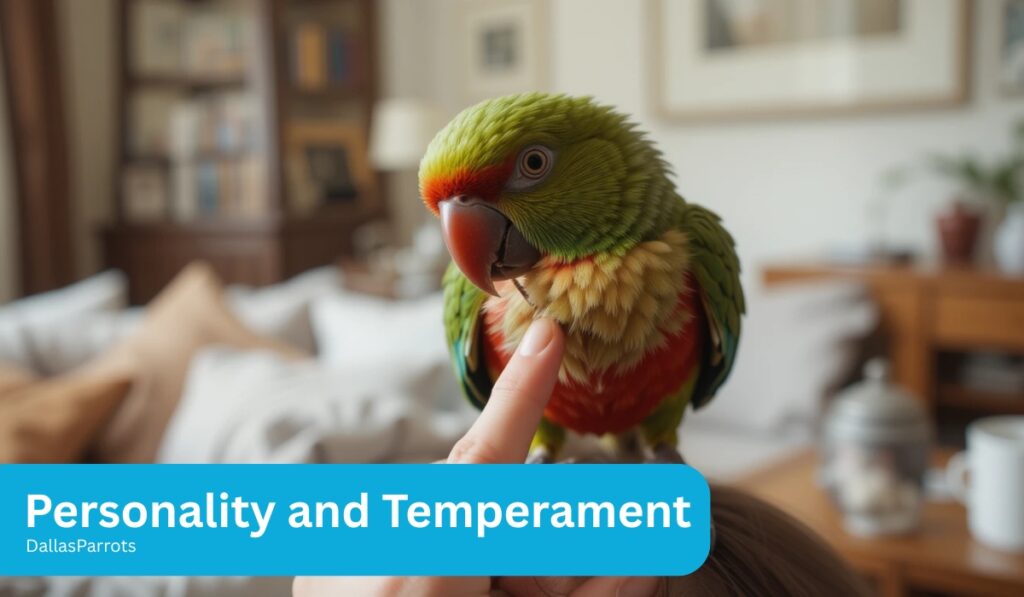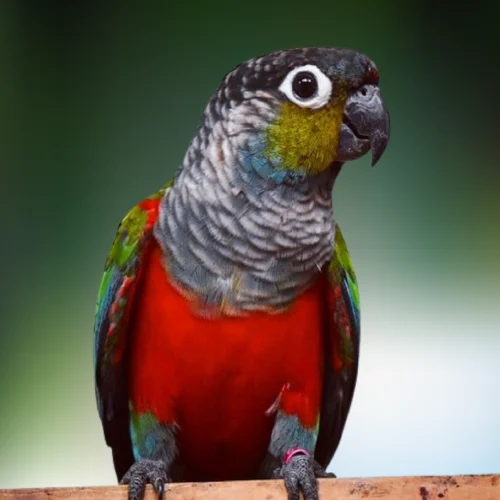

Crimson Bellied Conure Price, Lifespan, Care & Complete Guide
Crimson Bellied Conure is a parrot that instantly grabs attention with its vibrant colors and sweet personality. With a deep red belly, lush green feathers, and a touch of blue around the head, this bird is not only visually stunning but also known for being gentle, affectionate, and easy to care for. It’s no surprise that bird lovers everywhere are drawn to its calm nature and friendly behavior.
You need to know about the Crimson Bellied Conure From its price, lifespan, and diet, to how to provide the best daily care. Whether you’re planning to bring one home or just curious about this beautiful companion, this article will walk you through all the essentials to understand and enjoy this unique parrot.
Buy Our Delightful Crimson Bellied Conure at Dallas Parrots
Our Crimson Bellied Conures at Dallas Parrots are hand-raised with care and full of personality. These vibrant and affectionate birds are perfect for families, first-time bird owners, or anyone seeking a loyal avian companion. Click below to explore our available conures and bring home a lifetime of color and companionship.
Lifespan of the Crimson Bellied Conure
Crimson Bellied Conures, when given proper care, can live between 15 to 25 years in captivity, making them a long-term companion. Their lifespan is significantly influenced by factors such as their diet, environment, and mental stimulation. Regular vet checkups are essential for ensuring their well-being throughout their life.
A healthy conure will show signs like bright eyes, smooth feathers, and active behavior, indicating that their physical and emotional needs are met consistently. On the other hand, stress, poor hygiene, and an unbalanced routine can shorten their life.
While in the wild, their lifespan may be shorter due to predators and environmental changes, in a loving home, they thrive. It’s important to invest in their overall well-being, including their diet, mental stimulation, and regular health check-ups, to help them live a long and fulfilling life.
Physical Appearance
Crimson Bellied Conure is a small-sized parrot that easily stands out due to its vivid, multi-colored feathers and compact body. Its bright crimson abdomen contrasts beautifully with the lush green wings and cool-toned blue head, creating a balanced and eye-catching appearance. Subtle gray scalloping across the chest and a touch of metallic blue on the tail add extra depth to its plumage. The bird’s dark eyes, accented with a neat white eye-ring, give it a lively and expressive face, while its curved black beak complements its overall elegant look.
Feather Details:
The conure’s plumage shifts in shade depending on the lighting, especially the blue and green areas, which can appear iridescent in the sun.
Size and Shape:
On average, it grows to about 9 to 10 inches, with a slim build that makes it both easy to handle and agile in flight.
Personality and Temperament

Crimson Bellied Conure is a gentle and friendly parrot that quickly bonds with its human family. Known for being curious and playful, it loves to explore, interact, and be part of everyday activities. These birds thrive on companionship and enjoy being handled, talked to, and entertained. Their clever nature also makes them quick learners, especially when trained with patience and love.
Noise Levels and Talking Ability
Crimson Bellied Conure is known for having a gentle and quiet voice compared to other conures. While they do chirp and make light vocalizations throughout the day, their sounds are soft and not disruptive. Instead of loud calls, these parrots communicate more through their body language and playful gestures, making them less demanding in terms of vocal attention.
Mimicry Ability: They can mimic basic sounds or short phrases with regular interaction.
Apartment-Friendly: Their light chattering and lack of harsh screeches make them ideal for apartment living.
Diet and Feeding Tips
A well-balanced diet is essential for the health and well-being of your Crimson Bellied Conure. Providing a variety of high-quality pellets, fresh vegetables, and fruits will keep them active and vibrant. However, it’s important to avoid toxic foods like avocado, chocolate, and anything containing caffeine, as these can cause harm. Let’s dive into the best food choices for your conure to ensure they remain in the best health.
Diet and Feeding Guide:
| Food Type | Details |
| Pellets | High-quality pellets designed for conures. |
| Fresh Vegetables | Offer a variety of vegetables like spinach, carrots, and broccoli. |
| Fruits | Fruits like apples, berries, and grapes (in moderation). |
| Seeds | Occasional seeds, but not as a primary food source. |
| Toxic Foods to Avoid | Avocado, chocolate, and foods with caffeine |
Cage Setup and Living Conditions
The Crimson Bellied Conure requires a spacious cage to thrive, with a minimum size of 24″x24″. The cage should feature perches at different heights and made from various materials to encourage natural movement and exercise. Providing a variety of toys is crucial to keep them mentally stimulated and engaged. Ensuring the bird’s environment is clean and has good lighting and fresh air contributes to their overall health and comfort.
Mental Stimulation and Toys
Crimson Bellied Conure is an intelligent and curious bird that thrives on mental stimulation. To prevent boredom and encourage natural behaviors, it’s important to provide toys that challenge them. Interactive toys that involve you can also strengthen the bond between you and your conure while keeping them entertained. A variety of stimulating toys is essential to maintaining a happy and healthy conure.
Points for Mental Stimulation
- Puzzle Toys: Engage their intellect with puzzle toys that require problem-solving and interactive play.
- Shreddable Items: Provide natural, shreddable materials to satisfy their chewing and foraging instincts.
- Climbing Ropes: Include climbing ropes and swings to encourage physical activity and exploration.
- Interactive Toys: Interactive toys or games involving you will foster bonding while keeping them entertained.
Hygiene and Maintenance
Maintaining proper hygiene is essential for a Crimson Bellied Conure’s overall health and comfort. A clean cage is crucial for preventing infections and ensuring a healthy living space. Waste buildup, leftover food, and dirty perches can quickly lead to bacterial growth. Clean all surfaces, including perches, grates, and feeding bowls, at least once a week using a bird-safe disinfectant. Daily spot-cleaning helps reduce mess and keeps odors at bay.
Regular cleaning of their cage accessories, like perches, food bowls, and liners, also prevents the spread of bacteria. A clean, well-kept environment not only supports their health but also improves their mood and activity level, promoting overall well-being.
Bathing Needs
Crimson Bellied Conures are naturally drawn to water and enjoy regular bathing sessions. Offering a shallow bowl of clean water or gently misting them a few times a week helps maintain feather condition and supports skin health. Bathing also acts as a stress reliever and keeps your bird looking vibrant.
Nail and Beak Maintenance
While beak trimming is usually not required, occasional nail trimming might be necessary, especially if the conure isn’t wearing them down naturally. Use bird-specific clippers or consult an avian vet to trim them safely. Keep natural perches of varying textures in the cage to help maintain nail length between trims.
Breeding Behavior
Crimson Bellied Conures reach maturity around 2 years. To breed, they need a quiet and secure environment with a nesting box. Ensure their diet is rich in nutrients, and provide expert guidance to foster successful breeding. These birds may exhibit territorial behaviors during mating season, becoming more protective and selective. Recognizing signs like increased vocalization and nesting interest is key to knowing when they are ready to breed.
Legal and Ethical Considerations
When considering the adoption of a Crimson Bellied Conure, it’s essential to ensure that the bird comes from a licensed and ethical breeder. While these birds are not endangered, Purchasing captive-bred birds from responsible, ethical breeders helps support sustainable aviculture and avoids the risks associated with wild-caught parrots. Additionally, requesting health and lineage documentation is important to verify that the bird has been raised in humane and healthy conditions.
Misunderstandings and Myths
A common misconception is that all conures are loud and nippy, but this is far from the truth, especially with the Crimson Bellied Conure. In fact, this species is known for being among the quieter and gentler conures. With the right training and socialization, they can become affectionate, calm, and well-behaved companions. The idea that they are consistently loud or aggressive is an oversimplification that doesn’t apply to most individuals of this breed.
Conclusion
The Crimson Bellied Conure is a colorful, intelligent, and loving bird that makes a great companion for the right owner. With the information in this guide, you’re well on your way to becoming a responsible and confident bird parent. Take your time, do your research, and enjoy every moment of life with your feathery friend.
FAQ's
How long does a Crimson Bellied Conure live?
With proper care, a Crimson Bellied Conure can live between 15 to 25 years in captivity. Factors such as diet, environment, mental stimulation, and regular vet visits play a crucial role in their lifespan.
What kind of diet is best for a Crimson Bellied Conure?
A balanced diet should include high-quality pellets, fresh vegetables (like spinach and broccoli), and fruits (such as apples and berries in moderation). Avoid feeding them avocado, chocolate, or anything containing caffeine.
Is the Crimson Bellied Conure a loud bird?
No, it’s one of the quietest conure species. They produce soft chirps and light vocalizations, making them suitable for apartments and noise-sensitive homes.
Are Crimson Bellied Conures good for first-time bird owners?
Yes, their gentle temperament, affectionate nature, and relatively low noise levels make them an excellent choice for both beginners and families.
How often should I clean my Crimson Bellied Conure’s cage?
Do a daily spot clean for waste and leftover food, and perform a thorough cleaning weekly using a bird-safe disinfectant to maintain hygiene and prevent infections.
What kind of toys are best for mental stimulation?
Use puzzle toys, shreddable materials, climbing ropes, and interactive games to keep them mentally engaged and physically active.
Do Crimson Bellied Conures enjoy bathing?
Yes, they love water. Offer a shallow water dish or mist them a few times a week to keep their feathers healthy and vibrant.



